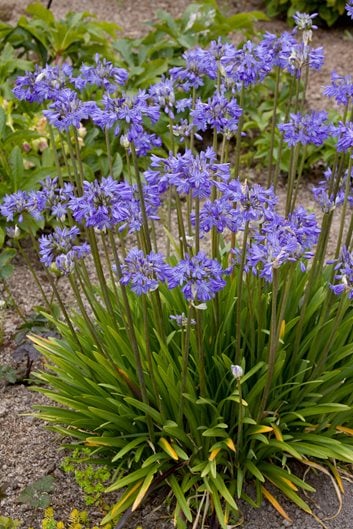Unleashing the Secret to Effective Agapanthus Growing: Tips and Tricks for a Flourishing Garden
In the world of horticulture, cultivating agapanthus successfully calls for a calculated approach that incorporates various elements of plant treatment. With mindful attention to information, one can open the tricks to nurturing these stunning blossoms, causing a yard that flourishes with elegance and vibrancy. By comprehending the nuances of agapanthus farming, one can produce an environment where these plants prosper and bloom perfectly. In the complying with conversation, we will explore important pointers and tricks that will certainly guide you in the direction of a thriving agapanthus yard, providing understandings into finest practices, soil problems, watering methods, and more.
Growing Agapanthus: Best Practices
When growing Agapanthus, correct soil preparation is crucial for ensuring successful growth and advancement of these lovely blossoms. Agapanthus, typically understood as Lily of the Nile or African lily, grows in well-draining dirt with a slightly acidic to neutral pH level - Agapanthus. Prior to growing, it is crucial to amend heavy clay soils with raw material such as garden compost or peat moss to improve drain and give important nutrients for the plants
To grow Agapanthus, choose a location that receives complete sunshine to partial shade, as this will promote healthy and balanced development and bountiful flowering. Dig a hole twice the diameter of the plant's root ball and place the Agapanthus at the exact same depth it was previously growing. Delicately backfill the opening with soil, pushing down firmly to remove any air pockets around the origins.
Water the freshly grown Agapanthus thoroughly and continue to keep the soil uniformly moist, especially during the plant's active expanding season. Agapanthus. Using a well balanced fertilizer once a month can even more sustain the plant's growth and blooming. By following these finest techniques for growing Agapanthus, you can produce a magnificent display of these captivating blossoms in your yard
Suitable Soil Issues for Agapanthus
For optimum growth and growing success of Agapanthus plants, making sure the soil problems are optimal is essential. Agapanthus prefers dirt that is rich in nutrients, so integrating a balanced plant food during the growing season can advertise healthy development and dynamic blossoms.

Watering and Feeding Tips
To guarantee healthy development and lively flowers, correct watering and fertilizing strategies are crucial for effective Agapanthus cultivation. Agapanthus plants benefit from normal watering, specifically during the growing period.
When it pertains to fertilizing Click This Link Agapanthus, a well balanced fertilizer with equal parts nitrogen, phosphorus, and potassium can be applied in the spring to advertise healthy development and flowering. Slow-release plant foods are perfect for offering nutrients gradually over a prolonged period. Stay clear of over-fertilizing, as this can cause excessive vegetation growth at the cost of flowers.
Furthermore, incorporating natural matter like garden compost into the dirt can improve nutrient levels and boost soil framework, helping in the total health and wellness of the Agapanthus plants. By following these watering and feeding tips, garden enthusiasts can ensure their Agapanthus plants prosper and produce sensational displays of blossoms.
Pruning and Deadheading Methods
Proper trimming and deadheading methods play an essential role in preserving the health and appearances of Agapanthus plants, complementing the crucial practices of watering and fertilizing for successful growing. Trimming Agapanthus includes removing spent blossom heads, dead or yellowing leaves, and total shaping of the plant to promote much better development. Deadheading, the procedure of removing faded blossoms, not just enhances the plant's look yet also motivates more blooming.
When deadheading Agapanthus, it is recommended to clip off the blossom stem at the base utilizing sharp, tidy shears. This procedure redirects the plant's energy from seed production back right into origin and vegetation development, promoting a much healthier and more durable plant. Normal deadheading can expand the growing period of Agapanthus and avoid self-seeding, which can cause overcrowding.
In regards to trimming, Agapanthus usually take advantage of a light trim after blossoming to clean up the plant and motivate fresh development. Cutting down the invested flower stems and eliminating any kind of broken or dead vegetation helps maintain the plant's vigor and overall appearance. Nevertheless, it is vital to prevent cutting into the crown of the plant, as this can weaken its health.

Protecting Agapanthus From Pests and Diseases
Executing reliable insect and illness monitoring techniques is crucial to guarding the health and vigor of Agapanthus plants in cultivation. One typical pest that impacts Agapanthus is the Agapanthus borer, a caterpillar that passages into the plant, triggering damages to the leaves and blossoms.
In addition to pests, Agapanthus are prone to illness such as origin rot and fungal fallen about his leave areas. By remaining attentive and resolving parasite and illness issues promptly, garden enthusiasts can assist their Agapanthus grow and prosper.

Final Thought
To conclude, successful farming of agapanthus needs proper growing methods, ideal dirt conditions, adequate watering and feeding, normal pruning and deadheading, and defense from bugs and diseases. By adhering to these techniques and tips, gardeners can make certain a growing yard full of attractive agapanthus flowers. Agapanthus. Bear in mind to preserve regular care and interest to detail to promote the health and longevity of these spectacular plants
When planting Agapanthus, correct soil prep work is essential for making certain effective growth and growth of these gorgeous blossoms.Water the freshly planted Our site Agapanthus completely and proceed to keep the soil uniformly wet, especially throughout the plant's energetic growing season.For ideal development and blooming success of Agapanthus plants, guaranteeing the dirt problems are excellent is critical. When planting or transplanting Agapanthus, ensure the soil is well-prepared to offer the needed structure for the plants to develop themselves successfully. One common bug that affects Agapanthus is the Agapanthus borer, a caterpillar that tunnels into the plant, triggering damages to the blossoms and leaves.
Comments on “Agapanthus Treatment Tips for Lush and Vibrant Flowers”